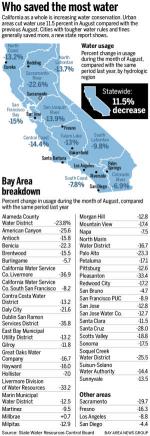California drought: State residents cut water use 11.5 percent

After months of seeming indifference to the state's historic drought, Californians are finally getting the message and sharply cutting back on water use, according to new figures released Tuesday.
The state's urban residents reduced water use 11.5 percent in August compared with the previous August. Although still short of the 20 percent savings that Gov. Jerry Brown requested in January, the number is up from a 7.5 percent cut in July and a 4.4 percent drop in June.
As lawns turned browner and reservoirs dried up, state residents used 27 billion gallons less water in August than the previous one -- an amount that would fill 41,000 Olympic swimming pools.
"We're pleased that the trend is continuing upward," said Felicia Marcus, chairwoman of the State Water Resources Control Board. "Every gallon saved now is a gallon that we won't have to ration in the future. We're already seeing such a devastating impact from this drought. And if it doesn't rain this winter, even more people are going to be in a world of hurt."
As in previous months, the cities with the toughest rules saw the biggest savings in the greater Bay Area.
Pleasanton and Livermore, with mandatory 25 percent cutbacks and fines for not reaching that percentage, cut use by 33.4 percent and 33.2 percent, respectively. And Santa Cruz, which limits all homes to 10 units of water a month and issues penalties of $50 per unit above that, saw a 28 percent reduction.
The board released water use totals from 394 cities, private water companies and water districts, which together deliver water to 33.5 million California residents. In July, as part of new statewide rules, the board required that all water providers with more than 3,000 customers report the data to the state every month.
By region, the Sacramento area showed the most savings, consuming 22.6 percent less water in August than the previous one. Bay Area residents overall cut water use 15 percent; their counterparts in the Los Angeles-San Diego area reduced it by 7.8 percent.
But that, Marcus noted, doesn't mean Southern Californians are water wasters. Many parts of Southern California, she said, have been reducing water steadily with conservation programs and rebates for water-efficient appliances since the state's last major drought, which stretched from 1987 to 1992. On the other hand, she added, Central Valley cities like Sacramento until recently had much higher per-capita water use.
The top water saver in the state was the tiny Bella Vista Water District, near Redding, which slashed use 50.7 percent. The agency had imposed mandatory rationing -- 50 gallons per person per day -- and penalties to cope with severe shortages in the third year of the drought.
"It was wildly unpopular," said David Coxey, the district's general manager. "But as you can see, we've had a tremendous response despite a lot of angst."
Among the state's worst water wasters: Southern California communities like La Habra, El Segundo and Huntington Park, which increased their use by 3.5 percent, 29.4 percent and 39.1 percent, respectively.
Most major Bay Area water providers reported savings that were above the state average.
The San Jose Water Co., which has 1 million customers, cut water use by 12.7 percent. Both the East Bay Municipal Utility District, which serves 1.3 million people in Alameda and Contra Costa counties, and the Contra Costa Water District reported a 13.2 percent savings.
"There was a lot of awareness in August about outdoor watering," said Abby Figueroa, a spokeswoman for East Bay MUD. "We heard from people. They were reporting water waste and leaky pipes. They were asking about conservation rebates."
The agency has a website where residents can report people who are wasting water: www.ebmud.com/reportwaterwaste. And it publicized new state rules over the summer requiring water districts to limit lawn watering and prohibit waste, such as watering so much that it runs into the street.
John Tang, a spokesman for San Jose Water, said the company has put videos on its website telling the public how to save water and how to read their water meters to help detect leaks. Calls for household water audits have doubled. And Santa Clara County now has five "water cops" who began working in September for the Santa Clara Valley Water District.
When members of the public call the district's hotline at 408-630-2000 to report water waste, the water cops pay the wasters a visit.
"It's very much an educational focus. One of the first things that comes out of their mouth is 'I'm not here to give you a fine,'" said district spokesman Marty Grimes. "And then they talk about how there was a complaint that water was running off into the sidewalk. People are generally very receptive and apologetic."
Although new state rules allow them to impose fines of up to $500, none of the Bay Area's largest water providers is fining anybody. That may change if the drought worsens, however.
Marcus, of the state water board, said that unless Californians continue to show more savings in the months ahead, her agency could issue tougher statewide rules, such as limiting lawn watering to one day a week or banning all daytime watering.
The state's major reservoirs are now barely one-third full. Its forests are tinder dry. And farms are desperately pumping groundwater to stay in business.
"We'll see what the numbers look like next month and decide if we need to take more dramatic actions," Marcus said.
Staff writer Katie Nelson contributed to this report. Paul Rogers covers resources and environmental issues. Contact him at 408-920-5045. Follow him at Twitter.com/PaulRogersSJMN.